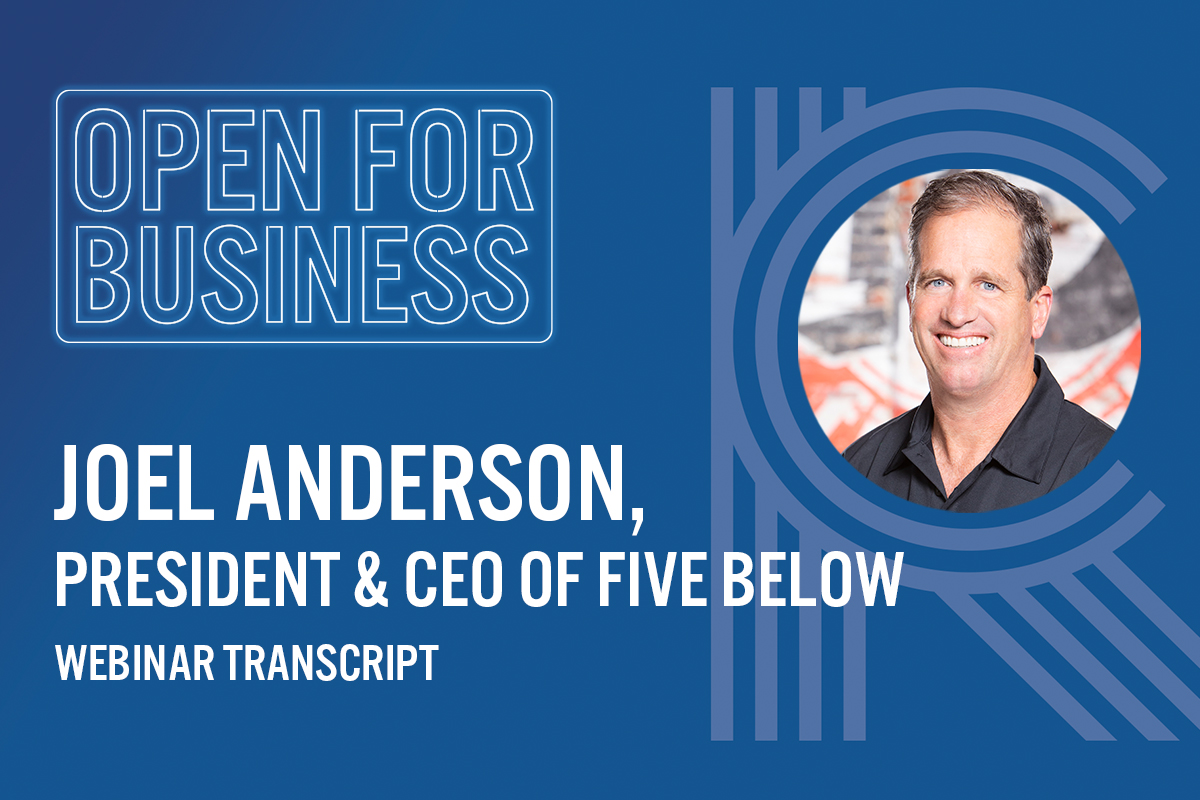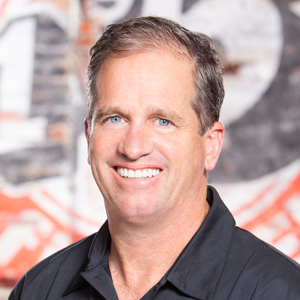
DIpil Das
We present an edited version of our conversation with Joel Anderson, CEO of Five Below, Inc., from the Coresight Research Open for Business webinar held on July 15, 2020. The webinar was hosted by Deborah Weinswig, CEO and Founder of Coresight Research.
 Joel Anderson has been President and CEO of Five Below, Inc. since February 2015. Prior to Five Below, Anderson was President and CEO of Walmart.com. He has also held leadership roles across a range of operational, merchandising and marketing functions at Walmart, Toys “R” Us and Lenox. Anderson currently serves on the boards of Sprouts Farmers Market and My Eye Doctor.
Joel Anderson has been President and CEO of Five Below, Inc. since February 2015. Prior to Five Below, Anderson was President and CEO of Walmart.com. He has also held leadership roles across a range of operational, merchandising and marketing functions at Walmart, Toys “R” Us and Lenox. Anderson currently serves on the boards of Sprouts Farmers Market and My Eye Doctor.
 Joel Anderson ; Deborah Weinswig.
Joel Anderson ; Deborah Weinswig.
Source: Coresight Research [/caption]
 Joel Anderson has been President and CEO of Five Below, Inc. since February 2015. Prior to Five Below, Anderson was President and CEO of Walmart.com. He has also held leadership roles across a range of operational, merchandising and marketing functions at Walmart, Toys “R” Us and Lenox. Anderson currently serves on the boards of Sprouts Farmers Market and My Eye Doctor.
Joel Anderson has been President and CEO of Five Below, Inc. since February 2015. Prior to Five Below, Anderson was President and CEO of Walmart.com. He has also held leadership roles across a range of operational, merchandising and marketing functions at Walmart, Toys “R” Us and Lenox. Anderson currently serves on the boards of Sprouts Farmers Market and My Eye Doctor.
Reopening Stores Post Covid-19
Can you talk about the reopening of stores post Covid-19 and the trends that you are seeing? When we shut down, health and safety of our associates was first and foremost. One of the best decisions we made during that period was that, while we did furlough a lot of people, we kept our store managers. That turned out to be really important, because we were in constant communication with them during the closure period, and they knew exactly what to do to get the stores reopened right. We have been opening new stores for a long time now, so that muscle memory of how to reopen stores is actually pretty good for us. We never thought we would use it to reopen our existing base! But as a company, we are pretty good at opening a lot of new stores all the time, and that served us well as we tried to get our stores back open. In terms of trends, it is really that theme around staying relevant—we’ve never sold so much hand sanitizer! We have always been relevant, and right now, essential products are really what have been important to the customer. Also, every parent is home with their kids as all schools shut down, and they are looking for an outlet—a way to entertain their kids—and our stores have been that outlet as we reopen. [caption id="attachment_114033" align="aligncenter" width="700"] Joel Anderson ; Deborah Weinswig.
Joel Anderson ; Deborah Weinswig.Source: Coresight Research [/caption]
Changing Consumer Behavior and Future Trends
What changes have you seen in this new environment? We will always be a “treasure hunt” retailer—I think that’s what makes this art of discovery when you walk into our stores. Customers don’t necessarily walk in with a list of things like you would in a grocery store, but they walk in to solve a solution. Our buyers do a great job at that. And certainly, as we reopen, we have really watched what the trends have been, and they are back in the market buying. We have got great partnerships, our buyers are talking overseas using video-call technology—back to China, back to India and some of the other countries we operate in. So, in some ways, the current situation has actually allowed us to go faster—we do not have to wait for a buying trip or a time to fly overseas, because that was basically rendered impossible during this time. So, they are using video technology to expedite and get that product back in our stores. The customer is where we have seen the biggest changes. Like many retailers, we are operating under shorter operating hours than we ever have. Our stores are only open from 11:00 a.m. to 7:00 p.m., so two things have happened:- We are seeing our customers consolidate trips; they are being very deliberate when they are out shopping.
- We have seen a migration from shopping at the weekends to during the week. We have seen a flattening of the Saturdays and that volume shifting into Monday through Thursday.
- We made a big investment last year in Nerd Street Gamers; we believe heavily in gaming and where that's going to go. That is just another example of how we are changing.
- We also changed our model when tariffs came along last year. That was the first time ever we broke the $5 price point. We have landed on the branding of “Five Beyond,” but what is not different is that it's all about value. We have an opportunity now to really bring incredible value to our customers in items above $5. We have the opportunity to be in different markets: We have gone into much more rural areas than we ever thought we would go; and we are also pushing further into markets.
- Self-checkout now will be in almost half our chain by the end of the year. We started working on that idea long before Covid came along, and the customer wants that self-isolating experience and checkout as part of it. For us to pivot from no self-checkout to half the chain in less than two years is an example of playing offense and constantly innovating.
- Holiday 2020 is going to be a different this year—but what I have learned from previous recessions is that the last place parents stop spending is their kids.
- We are going to have incredible gifts; now that we have Five Beyond, we are going to bring in some unique gifts that we have never had before.
- We also certainly think that there is going to be a bigger shopping experience online than we have had in the past.
- We have talked about being open 24 hours in December, just to give customers that need more space that time to come in the off hours.